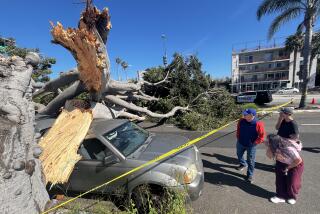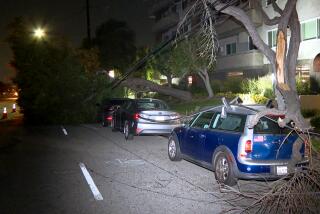Cleanup After Windstorms Begins
Besieged by a second night of ferocious winds, bleary-eyed residents in hard-hit areas emerged from their homes Tuesday into a landscape of toppled trees, dangling utility poles and splintered roofs--and a reminder of nature’s seemingly limitless genius for upending life in Southern California.
Once again, residents and officials across a wide belt from the San Fernando Valley east to San Bernardino County were thrown into the familiar cycle of assessing damage from nature’s latest act of caprice and cleaning up their battered yards.
Most of the damage was minor, but the windstorm’s sound and fury prompted comparisons to Southern California’s worst disaster. In terms of damage to the power supply and the number of homes left without power, the wind’s toll was ranked alongside the Northridge earthquake.
“We feel it’s had at least the impact of the ’94 earthquake,” said Ed Freudenburg, a spokesman for the Department of Water and Power. That utility and Southern California Edison reported that nearly 900,000 customers suffered at least temporary power failures over the two days. At least 32,000 homes and businesses were still without electricity, many for the second day.
Although the winds had died by daybreak and freeways were again open, some schools, public buildings and other facilities were shut because of overnight damage or outages. Windows were blown out at Pasadena City Hall and the 207-acre grounds of the Huntington Library in San Marino were closed after gusts toppled 25 trees and damaged numerous others.
Police set up a command post outside the South Pasadena Middle School, where one of five toppled utility poles rested atop the wood-working classroom. The school sat amid a neighborhood strewn with debris--bits of roof tile, twisted limbs, discarded Christmas trees--and a house one block away was nearly buried beneath an uprooted eucalyptus tree. The school was expected to remain closed today, police said.
Adriana Garibay, an 11-year-old student who lives nearby, said she was disappointed at having a free day away from school. “I really wanted to go to school today because it’s fun,” she said.
Utility officials said the hopscotching monster wind had made a maddening task of trying to restore power to stricken neighborhoods.
Crews from as far away as Houston were called in to join 200 Southern California Edison repair teams tackling a list of 6,700 places where poles had fallen, wires snapped or transformers were smashed. Edison also summoned 56 repair teams from utilities in Arizona, San Diego and the San Joaquin Valley under a mutual-aid arrangement among power companies. “This is the second-worst storm that Edison has ever suffered in its history,” said company spokeswoman Cathy Sedlik. The worst, she said, was a 1983 windstorm.
Officials weren’t the only people with talk of historic catastrophe on their lips. The winds, which claimed the life of 56-year-old Pacoima resident Albert Slatterly when a tree fell on him Monday, also left behind legions of shaken residents and fresh awe over Mother Nature’s powers.
“Since I moved into the house in 1991, we’ve had earthquakes, fires and now this,” said Adriana Lim, a 31-year-old Altadena resident who had to evacuate her home during a 1993 wildfire. “I’m waiting for locusts and the Angel 666 to appear through the clouds.”
Dorothy Real, a resident of Pasadena, among the hardest-hit areas, said she had not experienced such winds since leaving Washington state years ago. “But you never forget it once you’ve been in it,” Real said. “It really gives you a sense of how small we are.”
The Santa Ana winds, which kicked up Sunday night, reached speeds of more than 50 mph Monday night into early Tuesday, stirring trouble in foothill communities for a second night. A house in Azusa was charred to a shell after a tree fell across power lines and ignited sparks on the roof. All six residents fled to safety. “Our whole life is down the drain,” said Edmond Ramirez, 31.
The area’s most visible casualties were among its most cherished--many of the region’s most stately trees. In Altadena, powerful gusts toppled eight of the 144 deodar cedars that line Santa Rosa Avenue, also known as Christmas Tree Lane for its holiday light display.
Officials at the Los Angeles County Arboretum in Arcadia said the winds had uprooted at least 75 trees, some of them rare specimens. In Pasadena, 55-mph gusts damaged 430 trees along city streets, nearly all yanked up by the roots, and Arcadia also lost century-old Heritage Oaks.
The trees fell victim to a combination of high winds and rain-soaked ground that loosened the grip of their roots.
“It blew for so long. And with the ground being so wet, they just went down,” said Timothy Lindsay, the arboretum’s assistant superintendent.
The toppling trees set off a cascade of other troubles--snapped power lines, short-circuits and crushed transformers--that remained the most stubborn difficulties on Tuesday. Utility companies called in reinforcements from neighboring counties for an around-the-clock push to put it all back together. The sheer spread of the damage made the repair task as complicated as the one following the Northridge earthquake, where damage was concentrated in a smaller area, the DWP’s Freudenburg said.
The ever-shifting winds overnight frustrated the efforts of repair crews.
“As they got service restored in one area, it would go down in another,” DWP spokeswoman Debra Sass said. “So we were never really catching up.”
One city official faced with massive cleanup headaches managed to bring a little perspective to the problem.
Cynthia Kurtz, Pasadena’s assistant city manager, was a public works official in Portland, Ore., when the neighboring Mt. St. Helens erupted in 1980.
“We’ve had quakes, fires and now winds. But we haven’t had a volcano here yet,” Kurtz said. “When Mt. St. Helens went off it covered the entire city in half an inch of ash. Now that’s what you call a nightmare for public works.”
Times staff writer Solomon Moore and correspondent Richard Winton contributed to this story.
* FLOOD VICTIMS: Northern California residents take stock of their losses. A3
* LANDMARKS LOST: Historic cedars on Altadena’s Christmas Tree Lane felled. B1
More to Read
Sign up for Essential California
The most important California stories and recommendations in your inbox every morning.
You may occasionally receive promotional content from the Los Angeles Times.










